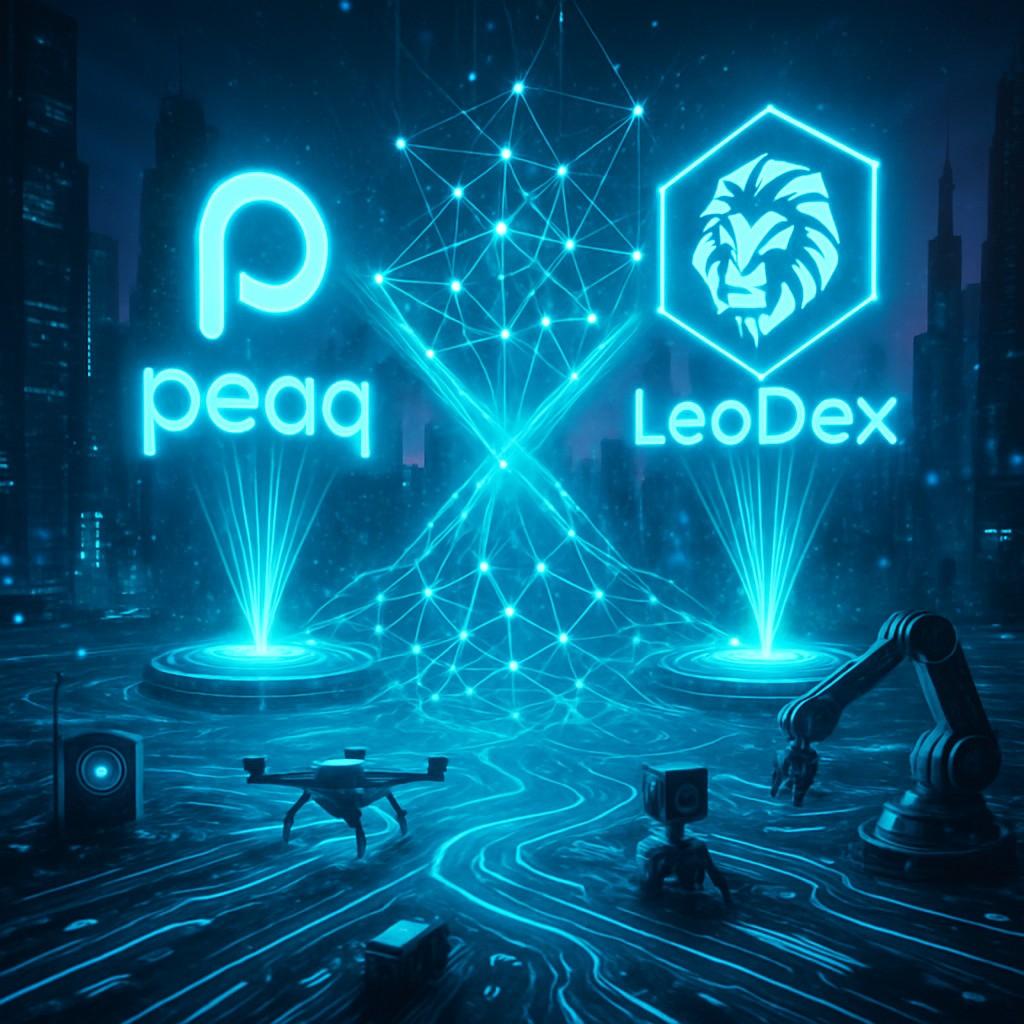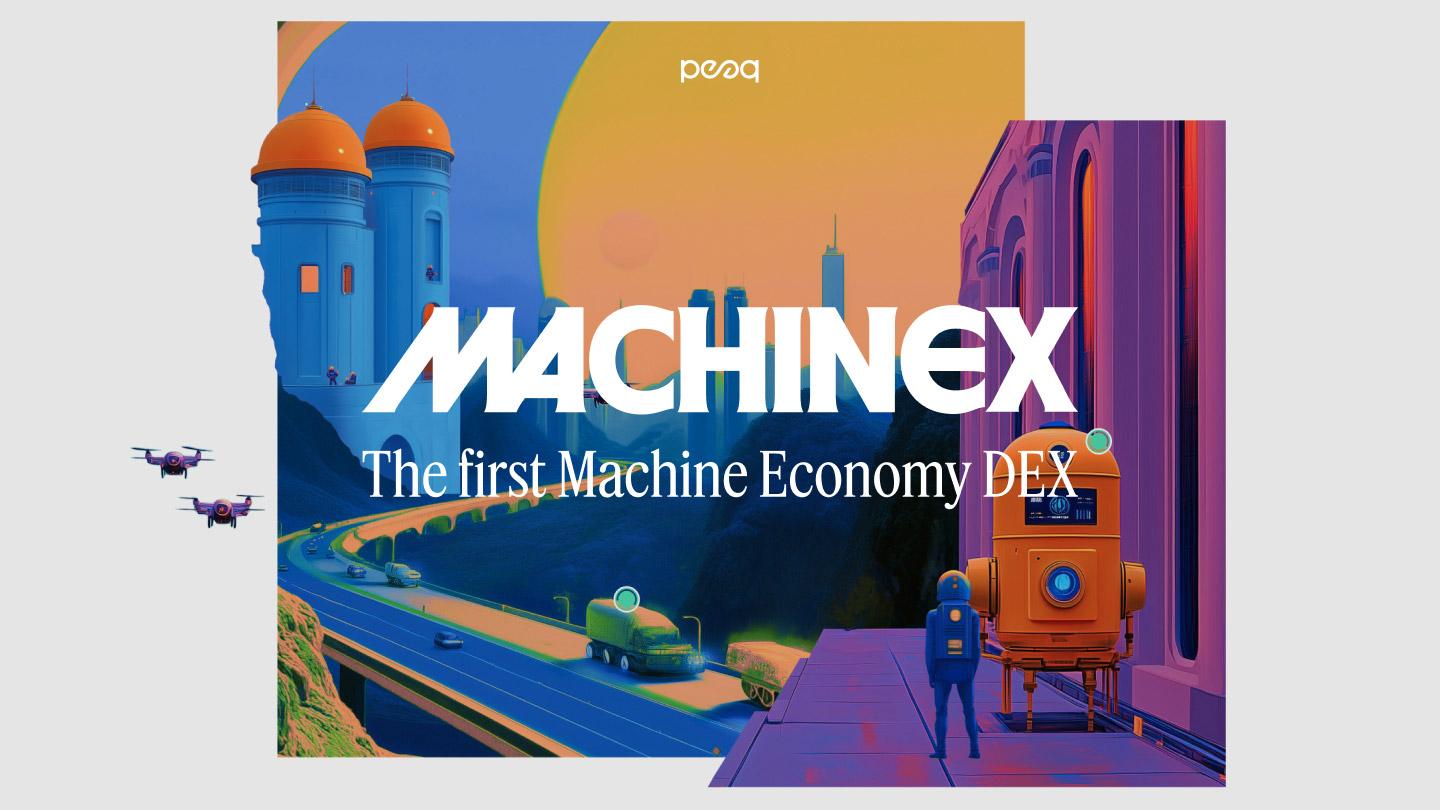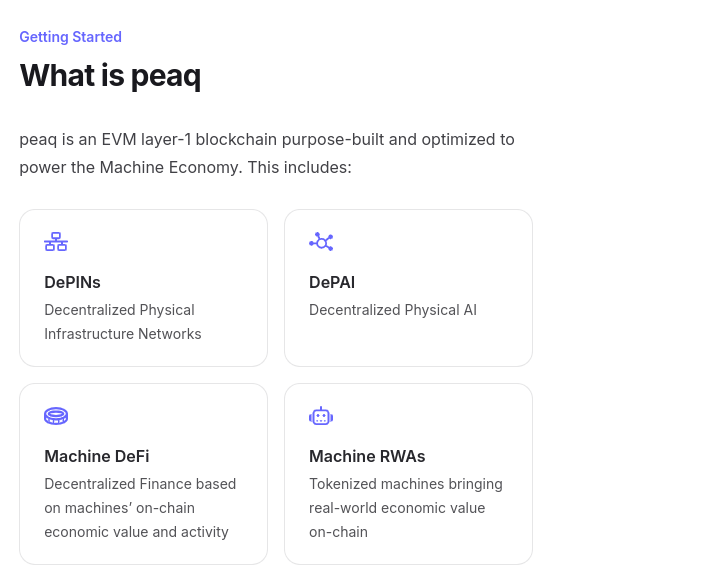This contribution, beyond evidencing that @khaleelkazi isn’t the only Lion to be waken up in the middle of the night by thoughts about how to make LeoDex even more successful and sustainable, tries to elaborate on the perspective molded by what @taskmaster4450 has been tirelessly sharing with us during dozens of «Lions Den» X Spaces and threadcasts:
What if LeoDex could become THE decentralized platform to facilitate high-volume machine-to-machine transactions across multiple blockchain networks, in a not-so-far-away future (and galaxy)?
To fuel such an evolution, LeoDex (and the whole LEO ecosystem) needs a solid partner, and, besides that, one that hasn’t yet fully unleashed the power of cross-chain DEX integration for its DePIN open source protocol. That’s where «peaq» comes into play.

A short introduction to peaq
peaq labels itself as «The Backbone of the Machine Economy» and is basically the only layer 1 blockchain purpose-built for DePINs (Decentralized Physical Infrastructure Networks) & DePAIs (Decentralized Physical Ais). Its model integrates robotics, agentic AI & Web3 infrastructure into a «Machine Economy»-tailored protocol that enables knowledge and resources to be shared and freely transacted in an open system instead of a dystopian corporations-owned siloed platforms oligopoly [see: «The Machine Economy, 50 DePIN Projects & Future of PEAQ - Leo Dorlöchter, https://inv.nadeko.net/watch?v=IfzyFZFT9IY].
That blockchain started as an enterprise focused IoT (Internet of Things) studio, back in 2017, then became a Polkadot parachain in 2020, and its layer 1 mainnet launched in November 2024 (yes, peaq operates simultaneously as both a Layer 1 blockchain and a Polkadot parachain - that dual architecture actually provides significant advantages). It brings to any DePIN project mechanisms to raise funds, a full Javascript SDK and dozens of other DePIN companies to connect with. Its roadmap includes elastic scaling to 100k TPS (machine-to-machine transactions per second) in the near future.
A close partnership between peaq and LeoDex’s cross-chain DEX interface represents, in my opinion, a highly strategic opportunity that could boost both platforms as leaders in the emerging Machine Economy and cross-chain DeFi sectors, including the building process of a promising DeFAI layer.
A technical architecture alignment that outlines a natural integration path
peaq's DePIN-optimized infrastructure provides an excellent foundation for cross-chain integration with LeoDex. Built on the Substrate framework, peaq already delivers 10,000 TPS, while maintaining transaction costs below $0.00025 [source: https://insights.blockbase.co/peaq-network-a-layer-1-blockchain-built-to-power-depins/].
The technical compatibility between the two architectures, from what I’ve seen after having read about it for a week, is very strong. peaq's full EVM compatibility & WASM support should enable a relatively smooth integration with LeoDex's existing infrastructure. Besides, peaq's multi-chain integrations with Polkadot XCM, LayerZero and established bridges to 30+ blockchains align directly with LeoDex's "connectivity over constructs" philosophy, and LeoDex's non-custodial architecture inherited from underlying protocols (like THORChain or Maya) ensures the overall security.
Strategic benefits boosting powerful mutual value proposition

Peaq has also recently launched «MachineX», the world's first Machine Economy-focused DEX, that provides native DePIN token support and machine-optimized trading features. In that regard, an integration with LeoDex would solve an infrastructure gap: while MachineX provides excellent native trading for DePIN tokens, peaq's Machine Economy vision requires seamless cross-chain functionality for the 53 currently active DePIN projects that have been onboarded to that ecosystem across 21 industries. LeoDex's integration with THORChain, Maya Protocol, and other cross-chain protocols would enable peaq's 2+ million connected devices to automatically swap assets, accept payments in any supported cryptocurrency, and optimize revenue across multiple blockchains.
For LeoDex, such a functional partnership would open access to an assessed $32 billion DePIN market [source: https://www.kucoin.com/learn/crypto/top-depin-crypto-projects] with genuine utility beyond trading. The millions of DePIN devices that belong to the peaq ecosystem represent sustainable trading volume based on real economic activity.
Peaq's enterprise partnerships with Bosch, Mastercard, Airbus and Continental can provide LeoDex with pathways into traditional business infrastructure, in a somewhat similar fashion to the opportunities that LeoMerchants is promising to trigger - a significant differentiator from purely crypto DEX aggregators.
The community benefits would also be substantial. As Lions & LeoDex users, we’d gain exposure to Machine Real World Asset (mRWA) backed tokens with actual revenue streams from physical infrastructure, providing portfolio diversification beyond traditional DeFi assets, while peaq users gain simplified access to broader DeFi ecosystems through LeoDex's innovative QR code swaps and multi-wallet support.
peaq's 2025 roadmap perfectly aligns with LeoDex capabilities. The planned Q3 2025 launch of «Machine DeFi Suite v2» with native stablecoin and money markets should create a demand for enhanced cross-chain trading functionality [source : https://messari.io/report/state-of-peaq-q2-2025]. peaq's Machine RWA Framework development coincides with LeoDex's proven ability to handle complex multi-asset trading across 25+ blockchains.

LeoDex’s THORChain routes «zero fee policy» impact
An added favorable factor is LeoDex’s current "zero fee" policy for THORChain swaps. It can represent a transformational jump for machine-to-machine transactions, therefore for peaq's Machine Economy integration: peaq’s connected devices could perform cross-chain swaps without the cumulative fee burden that typically "eats up gains" for regular traders [source: https://www.tumblr.com/taipanmagazine/689104947175948288/peaq-launches-open-source-polkadot-ecosystem] This is crucial because machines often need to make frequent, small-value transactions (micropayments for services, energy optimization, automated rebalancing).
The zero-fee model is also «automation friendly», as it removes from autonomous machine decision-making algorithms the barrier of sometimes complex fee calculation and management. Devices can execute swaps based purely on economic optimization without factoring in additional interface costs.
Machine Real World Assets can represent a paradigm shift for cross-chain trading. Let’s imagine together, as Lions, peaq's-powered physical infrastructure being tokenized and traded across LeoDex. What are we talking about here? Real World Assets like energy grids, computing clusters, IoT networks or autonomous vehicles.
A DeFi-ning partnership for Machine Economy infrastructure
We’re barely scratching the surface of the potential synergies, as a closely related field is «autonomous machine commerce». I can envision it as a segment of LeoMerchants’ volume, as the LeoDex x LeoMerchants «trade engine» makes possible for devices to seamlessly swap assets to pay for services, and to settle accounts across different blockchain networks. A Tesla charging at a peaq-connected station could automatically pay in the optimal cryptocurrency, while the charging station could immediately convert payment to its preferred asset - all through LeoDex's cross-chain infrastructure 😋 .
Moreover, market trends in DePIN growth, cross-chain adoption, and AI agent development all support this integration.
Thanks a lot for having read this suggestion from a humble Lion who’s utterly enthusiastic about LeoDex’s & INLEO’s potential!
Posted Using INLEO